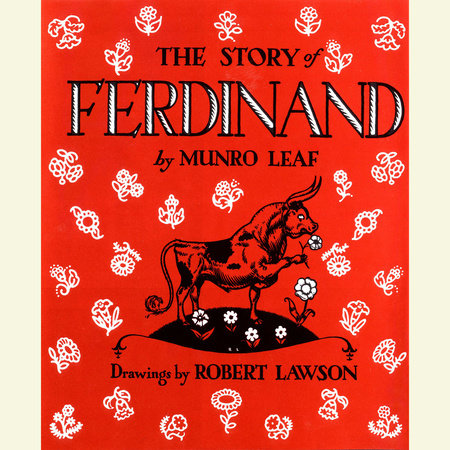The Story of Ferdinand (1936) written by Munro Leaf and Illustrated by Robert Lawson
We don’t often put context behind our favorite picture books. Why would we? It’s the words and the pictures on the page that matter. However, there are a surprising amount of famous picture books that are popular today that had a bad rep way back when. “Once upon a time in Spain…there lived a bull and his name was Ferdinand.” Sound familiar? Fans of the classic picture book The Story of Ferdinand, written by Munro Leaf and illustrated by Robert Lawson, may recognize this line—not to mention the most recent animated film adaptation released at the end of 2017!
The story goes like this: Ferdinand is a gentle bull who spends his days smelling flowers. One day, Ferdinand accidentally sits on a bee—ouch! He thrashes around so much from pain and discomfort that everyone is certain that he will be a fierce ring opponent for the matador in Madrid. He becomes Ferdinand the Fierce. However, there’s one big problem…Ferdinand isn’t fierce at all! When he enters the ring, all he wants to do is smell the flowers in the women’s hair and the flowers that have been thrown into the ring for the matador. The fight is cancelled and Ferdinand is sent home where he can smell flowers all day long just the way he likes to.
One of the biggest take-away messages from The Story of Ferdinand is to just be yourself and not care what other people think—to do what makes you happy as long as you’re not hurting anyone else in the process. That’s a pretty good message. In fact, it’s something we tell kids all the time, it’s the advice we give to our peers, and it’s something we have to remind ourselves of every once in a while. You do you, right?
It might be surprising to some people that The Story of Ferdinand was actually banned in certain places upon its publication. Why? Because it’s anti-war, pacifist propaganda of course! Wait, what? Let’s rewind. The picture book was published in 1936 by Viking Press and sold about 14,000 copies for $1 each, and by the end of 1938, the book was selling about 3,000 copies per week. That’s great news! So what’s the big deal? Why is it anti-war, pacifist propaganda? Well, because it was published nine months before the outbreak of the Spanish Civil War. Supporters of Francisco Franco, who ruled Spain as a dictator from 1939 to 1975 after a Nationalist victory in the war, viewed Leaf’s book as way too political for the time.
Over and over again The Story of Ferdinand—a picture book emphasizing the need to be true to yourself—was banned for promoting pacifism, fascism, anarchism, and communism. That’s a lot of isms for a picture book. Do all of these possible political allegories even matter if the ban on the book was lifted after WWII? Today, we read the book as it was most likely intended to be read: a feel good book about being yourself! But yeah, maybe those possible political allegories still matter. After all, we’ve got our own problems in this day and age. What can modern readers away from this literary classic? Or maybe the question should be: What do modern viewers of the newest film adaptation take away from the movie?
Let’s think about some of the problems that are prevalent in our world today. Some of them are super obvious and some of them, well, not so much. A majority of us probably don’t even think about some of the issues that the 2017 film raised. What are those issues? Maybe you had the pleasure of seeing the movie in late 2017 or early 2018, maybe you waited for the Blu-Ray and DVD. Even if you haven’t seen the movie, take a week to think about it what those issue could possibly be, and we’ll address them next time.
PRR Writer, Cheyenne Lopex
